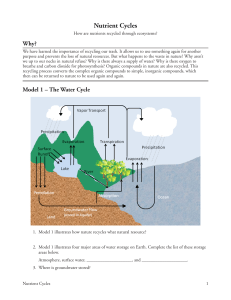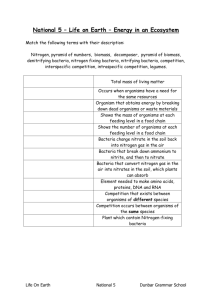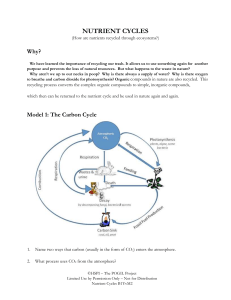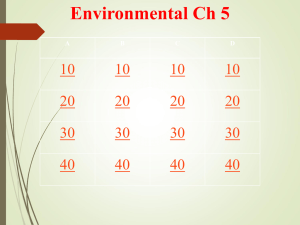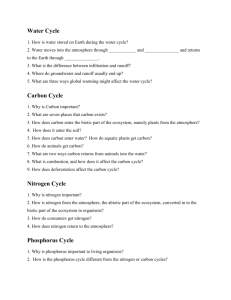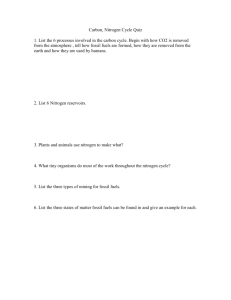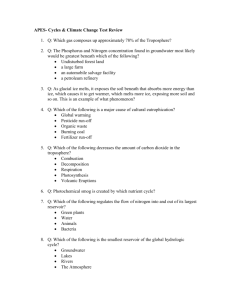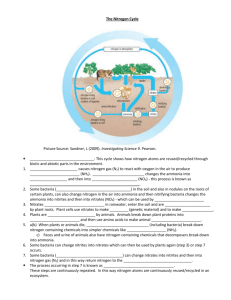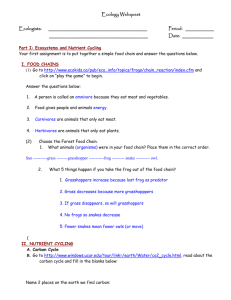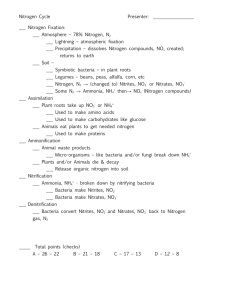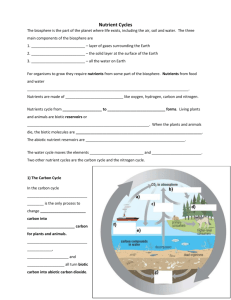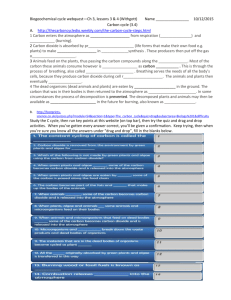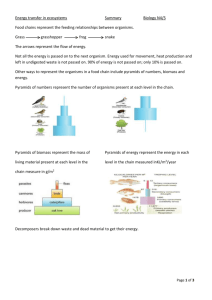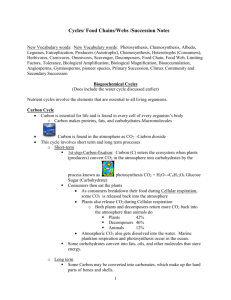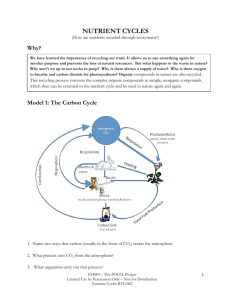Nutrient Cycles water cycle answers
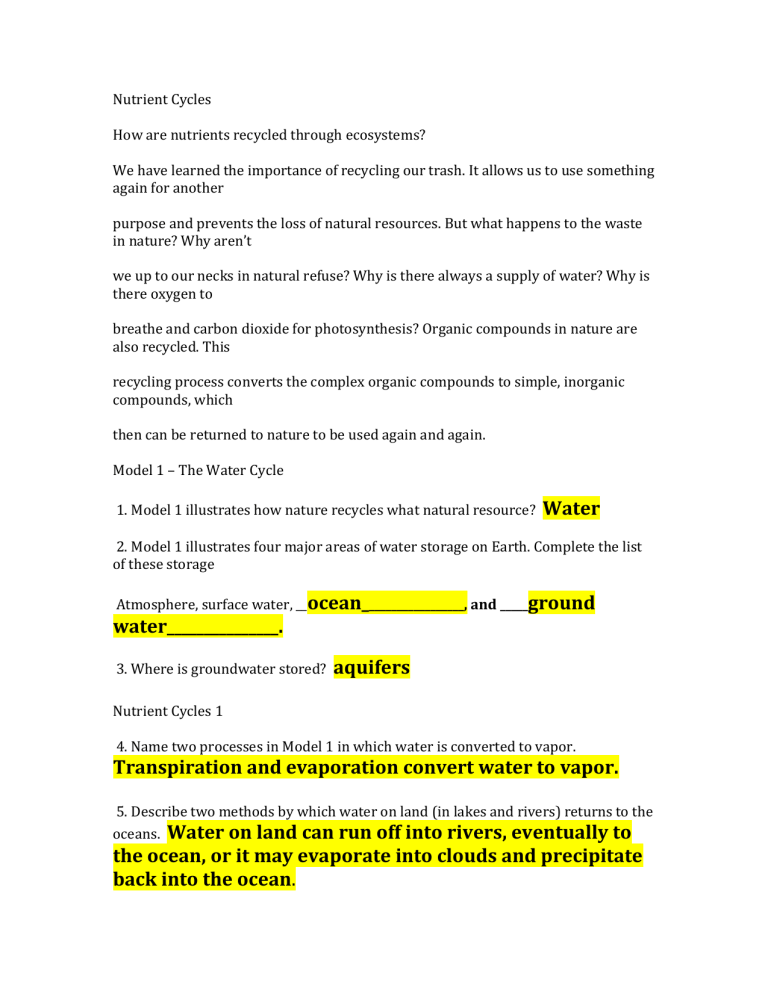
Nutrient Cycles
How are nutrients recycled through ecosystems?
We have learned the importance of recycling our trash. It allows us to use something again for another purpose and prevents the loss of natural resources. But what happens to the waste in nature? Why aren’t we up to our necks in natural refuse? Why is there always a supply of water? Why is there oxygen to breathe and carbon dioxide for photosynthesis? Organic compounds in nature are also recycled. This recycling process converts the complex organic compounds to simple, inorganic compounds, which then can be returned to nature to be used again and again.
Model 1 – The Water Cycle
1. Model 1 illustrates how nature recycles what natural resource?
Water
2. Model 1 illustrates four major areas of water storage on Earth. Complete the list of these storage
Atmosphere, surface water, __ ocean_
_________________, and _____ ground water_______________.
3. Where is groundwater stored? aquifers
Nutrient Cycles 1
4. Name two processes in Model 1 in which water is converted to vapor.
Transpiration and evaporation convert water to vapor.
5. Describe two methods by which water on land (in lakes and rivers) returns to the oceans.
Water on land can run off into rivers, eventually to the ocean, or it may evaporate into clouds and precipitate
back into the ocean.
6. Rain, sleet, and snow are examples of what?
Precipitation
7. If the air contains high levels of pollutants, what effect might this have on water quality?
The water can become acidic or polluted, also.
8. Which process(es) of the water cycle—precipitation, evaporation, condensation, runoff, percolation or transpiration—might contribute to the addition of pollutants to rivers, lakes?
Evaporation and runoff from farmland can pollute. Condensation in polluted atmosphere from factories can also add pollutantvvs.
9. Which of the processes associated with the water cycle might be responsible for helping to clean ?
Plants using water and giving it off as waste might clean the water, and also the earth might clean water like a filter when it runs underground, but there is not really a way to clean the pollution, well. Some bacteria might eat it, like BP used during the last oil spill, but not all of it.
10. The water cycle is a closed system, meaning no water enters from beyond the system nor leaves the system. What does that say about the importance of keeping the water on Earth free from pollution?
Ecology and conservation is very important!!!!! Save the earth from pollution!!!!
2 POGIL™ Activities for High School Biology
Model 2 – The Carbon Cycle
D
Atmospheric
CO2
B
Respiration
Wastes
C
Respiration
Feeding
Death
Decay
(by decomposing fungi, bacteria, and worms)
Fossil Fuel Formation
Carbon Sink
(coal, oil, peat, natural gas)
11. Model 2 illustrates how nature recycles what natural resource?
12. Name two ways that carbon (usually in the form of CO2
) enters the atmosphere.
13. Process D on the diagram uses CO2 a. Label D on the diagram in Model 2 with the name of this process. b. What organisms carry out the process identifi ed in part a?
from the atmosphere.
14. Wastes and dead organisms must be broken down in order for their components to be used a. What organisms in the cycle carry out this process?
b. What would happen if decomposition did not occur?
Nutrient Cycles 3
15. Not all dead organisms are acted on by decomposers. Instead of being immediately recycled, the carbon from some organisms is kept in a type of long-term storage, or carbon sink.
Using Model
2, answer the questions below about this long-term storage. a. List four materials that contain this stored carbon. b. What is the collective term for these four materials? c. How do humans use the materials in the carbon sink? d. What is the scientifi c name for the process listed in part c?
16. List fi ve examples of combustion in your everyday life.
17. How is the majority of electricity generated in the area where you live? Does the process involve the combustion of coal? Check with your teacher if you are not sure.
18. Many of the carbon-based fuels are categorized as fossil fuels because they formed from decayed organisms over millions of years. List as many examples of fossil fuels as you can.
19. How does our use of these carbon stores affect the amount of CO2
in the atmosphere?
) is one of the so-called greenhouse gases. These gases hold heat energy in the atmosphere, which raises the overall temperature of the Earth. This helps maintain the Earth’s biosphere, but also has led to environmental concerns. The more CO2
20. What is another way in which human activity is increasing the amount of atmospheric CO2 what are potential global effects of these changes in CO2
in the atmosphere, the higher the Earth’s
levels?
4 POGIL™ Activities for High School Biology
Model 3 – The Nitrogen Cycle
Denitrification by denitrifying baceria Further nitrification by
Nitrites Nitrates
Nitrates in soil
Atmospheric
Nitrogen
(N2)
Absorption by roots of non- legume plants
Feeding
Death
Nitrogen fixation
Lightning
Death
Decomposition
N-fixing bacteria
(Found in root nodules of legumes)
(by fungi, bacteria, and worms)
N-fixing bacteria
21. Model 3 illustrates how nature recycles what natural resource?
22. Name three types of bacteria involved in the nitrogen cycle.
Nitrification is a process by which specific bacteria convert different forms of Ncontaining compounds only forms of nitrogen that are usable by plants to build their proteins are the nitrates.
) in the soil to nitrites (NO2
) and nitrates (NO3
). This process is important since the
gas removed from the atmosphere?
24. By what process are animal wastes and dead organisms converted to other nitrogen-containing
Nutrient Cycles 5
25. What is the only form of nitrogen that nonlegume plants can take in and use?
26. What do the denitrifying bacteria do during the denitrifying process?
27. If the number of nitrifying bacteria decreased, what effect would this have on the nitrogen cycle and what type of compounds would accumulate as a result?
6 POGIL™ Activities for High School Biology
28. Plants and animals are part of all of the nutrient cycles through the foods they eat and what eats them (food chains and food webs). Name the four classes of organic compounds
(containing carbon) and explain how the carbon cycle and nitrogen cycle contribute to the usable supplies of
29. In order to continually use the same area of land for agriculture, some farmers apply fertilizers to improve the level of nitrates in the soil. An alternative to this intensive use of fertilizer is to plow the roots of the leguminous plants back into the soil and leave the area unplanted for a season.
Why would a farmer use this alternative method and what would be the benefit of turning over the soil and leaving the old plant roots?
Nutrient Cycles 7
